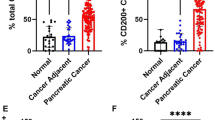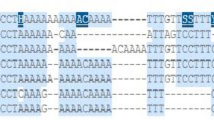Abstract
Dysregulation of the immune system may play important roles in the development of colorectal cancer (CRC). The C-X-C chemokine receptor type 5 (CXCR5) is one of the principal regulators for targeting T cells, B cells, and dendritic cells into secondary lymphoid organs. The current study investigated the association between CXCR5 gene polymorphisms and the risk of CRC, and the potential effect of these polymorphisms on different immune cells. Two polymorphisms in CXCR5 gene, rs6421571C/T and rs80202369G/A, were examined by polymerase chain reaction–restriction fragment length polymorphism (PCR–RFLP) in 302 cases and 316 controls. Results showed that individuals with the rs6421571CT and TT genotypes had a strong correlation with the incidence of CRC (odds ratio (OR) = 1.46; 95 % confidence interval (CI), 1.02–2.09; p = 0.041 and OR = 2.62; 95 % CI, 1.50–4.95; p < 0.001, respectively). Also, rs80202369AA genotype revealed significantly higher distribution in CRC patients than in controls (p = 0.002). We further investigated the possible effects of the polymorphisms by assessing messenger RNA (mRNA) and protein levels of CXCR5 in peripheral blood mononuclear cells (PBMCs), CD4+ T cells, CD8+ T cells, and B cells. Data presented that healthy controls with rs6421571CT and TT genotypes had higher mRNA and protein levels of CXCR5 than those with wild-type CC genotype specifically in CD4+ T cells. These findings suggest novel risk factors of CRC and indicate a potential mechanism of CXCR5 gene polymorphism.


Similar content being viewed by others
References
Karantanos T, Theodoropoulos G, Pektasides D, Gazouli M. Clock genes: their role in colorectal cancer. World J Gastroenterol. 2014;20:1986–92.
Vaiopoulos AG, Athanasoula KC, Papavassiliou AG. Epigenetic modifications in colorectal cancer: molecular insights and therapeutic challenges. Biochim Biophys Acta. 2014.
Biswas S, Sengupta S, Roy Chowdhury S, Jana S, Mandal G, et al. CXCL13-CXCR5 co-expression regulates epithelial to mesenchymal transition of breast cancer cells during lymph node metastasis. Breast Cancer Res Treat. 2014;143:265–76.
Boswell KL, Paris R, Boritz E, Ambrozak D, Yamamoto T, et al. Loss of circulating CD4 T cells with B cell helper function during chronic HIV infection. PLoS Pathog. 2014;10:e1003853.
Charbonneau B, Wang AH, Maurer MJ, Asmann YW, Zent CS, et al. CXCR5 polymorphisms in non-Hodgkin lymphoma risk and prognosis. Cancer Immunol Immunother. 2013;62:1475–84.
Humpert ML, Pinto D, Jarrossay D, Thelen M. CXCR7 influences the migration of B cells during maturation. Eur J Immunol. 2014;44:694–705.
Kobayashi S, Murata K, Shibuya H, Morita M, Ishikawa M, et al. A distinct human CD4+ T cell subset that secretes CXCL13 in rheumatoid synovium. Arthritis Rheum. 2013;65:3063–72.
Li Y, Ma S, Tang L, Li Y, Wang W, et al. Circulating chemokine (C-X-C Motif) receptor 5(+) CD4(+) T cells benefit hepatitis B e antigen seroconversion through IL-21 in patients with chronic hepatitis B virus infection. Hepatology. 2013;58:1277–86.
Park HJ, Kim DH, Lim SH, Kim WJ, Youn J, et al. Insights into the role of follicular helper T cells in autoimmunity. Immune Netw. 2014;14:21–9.
Shi W, Li X, Cha Z, Sun S, Wang L, et al. Dysregulation of circulating follicular helper T cells in nonsmall cell lung cancer. DNA Cell Biol. 2014.
Stuart MJ, Corrigan F, Baune BT. Knockout of CXCR5 increases the population of immature neural cells and decreases proliferation in the hippocampal dentate gyrus. J Neuroinflammation. 2014;11:31.
Xiao H, Luo G, Son H, Zhou Y, Zheng W. Upregulation of peripheral CD4+CXCR5+ T cells in osteosarcoma. Tumour Biol. 2014.
Barroso R, Martinez Munoz L, Barrondo S, Vega B, Holgado BL, et al. EBI2 regulates CXCL13-mediated responses by heterodimerization with CXCR5. FASEB J. 2012;26:4841–54.
Jiang J, Karimi O, Ouburg S, Champion CI, Khurana A, et al. Interruption of CXCL13-CXCR5 axis increases upper genital tract pathology and activation of NKT cells following chlamydial genital infection. PLoS One. 2012;7:e47487.
Leon B, Ballesteros-Tato A, Browning JL, Dunn R, Randall TD, et al. Regulation of T(H)2 development by CXCR5+ dendritic cells and lymphotoxin-expressing B cells. Nat Immunol. 2012;13:681–90.
Pallikkuth S, Parmigiani A, Silva SY, George VK, Fischl M, et al. Impaired peripheral blood T-follicular helper cell function in HIV-infected nonresponders to the 2009 H1N1/09 vaccine. Blood. 2012;120:985–93.
Pranzatelli MR, Tate ED, McGee NR, Travelstead AL, Ransohoff RM, et al. Key role of CXCL13/CXCR5 axis for cerebrospinal fluid B cell recruitment in pediatric OMS. J Neuroimmunol. 2012;243:81–8.
Quan C, Yu H, Qiao J, Xiao B, Zhao G, et al. Impaired regulatory function and enhanced intrathecal activation of B cells in neuromyelitis optica: distinct from multiple sclerosis. Mult Scler. 2013;19:289–98.
Razis E, Kalogeras KT, Kotoula V, Eleftheraki AG, Nikitas N, et al. Improved outcome of high-risk early HER2 positive breast cancer with high CXCL13-CXCR5 messenger RNA expression. Clin Breast Cancer. 2012;12:183–93.
Sambandam Y, Sundaram K, Liu A, Kirkwood KL, Ries WL, et al. CXCL13 activation of c-Myc induces RANK ligand expression in stromal/preosteoblast cells in the oral squamous cell carcinoma tumor-bone microenvironment. Oncogene. 2013;32:97–105.
Smedbakken LM, Halvorsen B, Daissormont I, Ranheim T, Michelsen AE, et al. Increased levels of the homeostatic chemokine CXCL13 in human atherosclerosis—potential role in plaque stabilization. Atherosclerosis. 2012;224:266–73.
Song H, Tong D, Cha Z, Bai J. C-X-C chemokine receptor type 5 gene polymorphisms are associated with non-Hodgkin lymphoma. Mol Biol Rep. 2012;39:8629–35.
Crotty S. Follicular helper CD4 T cells (TFH). Annu Rev Immunol. 2011;29:621–63.
Conflict of interest
None
Author information
Authors and Affiliations
Corresponding authors
Additional information
Junjie Xing, Xu Li, and Jinke Sui contributed equally to the work.
Rights and permissions
About this article
Cite this article
Xing, J., Li, X., Sui, J. et al. C-X-C chemokine receptor type 5 gene polymorphism affects gene expression in CD4+ T cells and is associated with increased risk of colorectal cancer. Tumor Biol. 35, 7929–7934 (2014). https://doi.org/10.1007/s13277-014-2069-8
Received:
Accepted:
Published:
Issue Date:
DOI: https://doi.org/10.1007/s13277-014-2069-8




